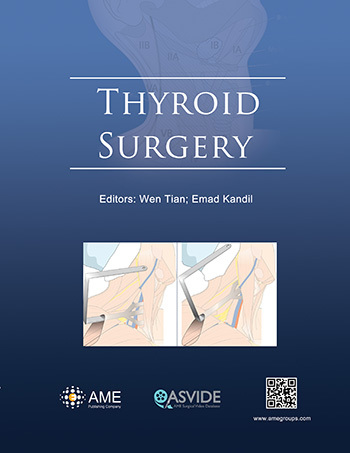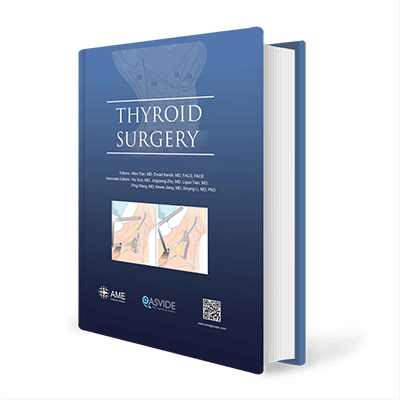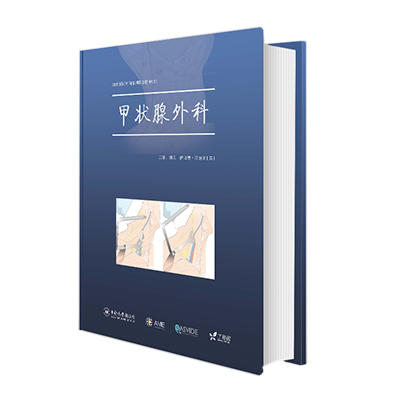
Thyroid Surgery
| Editors: | Wen Tian; Emad Kandil |
Publisher: AME Publishing Company (2015)
ISBN-13: 978-9881402745
Hardcover: 312 pages
Language: English
Recent data on surgery for thyroid malignancies show an annual incidence of 7-9 per 100,000 inhabitants (1-3). Since malignant thyroid tumors account for 25-30% of all thyroid procedures, the number of procedures carried out for all thyroid diseases may easily be as high as 30-40 per 100,000 habitants. When performed by experienced surgeons, thyroidectomy is a highly safe procedure, with a low risk of injury to the recurrent laryngeal nerves (RLN)
Editors
| Wen Tian | Department of General Surgery, General Hospital of the People’s Liberation Army (PLA), Beijing 100853, China |
| Emad Kandil | Edward G. Schlieder Chair in Surgical Oncology, Chief of Endocrine Surgery Section, Tulane University School of Medicine, New Orleans, USA |
Associate Editors
| Hui Sun | Department of Thyroid Surgery, China-Japan Union Hospital of Jilin University, Changchun 130033, China |
| Jingqiang Zhu | Department of Thyroid & Breast Surgery, West China Hospital, Sichuan University, Chengdu 610041, China |
| Liguo Tian | Editorial office, Chinese Journal of Practical Surgery, Shenyang 110001, China |
| Ping Wang | Second Affiliated Hospital of Medical College of Zhejiang University, Hangzhou 310009, China |
| Kewei Jiang | Department of Gastrointestinal Surgery, People’s Hospital of Peking University, Beijing 100044, China |
Table of Content
Foreword
Preface
Basic Research of Thyroid Tumors
1 A benign genomic classifier for thyroid nodules with indeterminate cytology: a critical appraisal
3 Preoperative diagnosis of benign thyroid nodules with intermediate cytology
6 The role of noncoding RNA in thyroid cancer
11 Expressions of D2-40, CK19, galectin-3, VEGF and EGFR in papillary thyroid carcinoma
19 Abnormality of pl6/p38MAPK/p53/Wipl pathway in papillary thyroid cancer
Thyroid Surgery
25 Does nodule size predict compressive symptoms in patients with thyroid nodules?
30 Is there a case for selective, rather than routine, preoperative laryngoscopy in thyroid surgery?
41 Loss of signal in recurrent nerve neuromonitoring: causes and management
49 Management of anaplastic thyroid cancer
57 Recurrence of papillary thyroid cancer after optimized surgery
68 Defining the syndromes of parathyroid failure after total thyroidectomy
77 Recovery of laryngeal function after intraoperative injury to the recurrent laryngeal nerve
86 Electrophysiological neural monitoring of the laryngeal nerves in thyroid surgery: review of the current literature
94 Esophageal recurrence of medullary thyroid carcinoma
97 Negative developing of parathyroid using carbon nanoparticles during thyroid surgery
99 Prediction of ipsilateral and contralateral central lymph node metastasis in unilateral papillary thyroid carcinoma: a retrospective study
106 The presentation of lymph nodes in Hashimoto’s thyroiditis on ultrasound
112 A cost analysis of thyroid core needle biopsy vs. diagnostic surgery
Parathyroid Surgery
117 Parathyroid cancer
127 Different surgical approaches in parathyroid adenoma resections
130 “Parathyroidectomy in pregnancy”—a single centre experience with review of evidence and proposal for treatment algorithim
137 Parathyroid carcinoma: a silent presentation
141 The current status of intraoperative iPTH assay in surgery for primary hyperparathyroidism
149 Minimally invasive parathyroid surgery
159 Undescended parathyroid adenomas as cause of persistent hyperparathyroidism
Neck Dissection in Differentiated Thyroid Carcinoma
165 Technical hints and potential pitfalls in modified radical neck dissection for thyroid cancer
171 The effect of neck dissection on quality of life in patients with differentiated thyroid cancer
179 The pros and cons of routine central compartment neck dissection for clinically nodal negative (cN0) papillary thyroid cancer
189 Involvement of level IIb lymph node metastasis and dissection in thyroid cancer
195 The prognostic implication and potential role of BRAF mutation in the decision to perform elective neck dissection for thyroid cancer
201 Neck dissection with cervical sensory preservation in thyroid cancer
208 The pros and cons of prophylactic central neck dissection in papillary thyroid carcinoma
Video-assisted and Robotic-assisted Thyroid/parathyroid Surgery
218 Remote access thyroid surgery
230 Transoral robotic thyroid surgery
236 Robotic transaxillary thyroid surgery
242 Transaxillary single-incision robotic neck dissection for metastatic thyroid cancer
251 Video-assisted surgery for thyroid cancer patients
254 Robotic facelift thyroid surgery
261 Robotic transaxillary and retroauricular parathyroid surgery
270 Single incision robotic transaxillary approach to perform parathyroidectomy
Guideline
272 Clinical guidelines on intraoperative neuromonitoring during thyroid and parathyroid surgery
281 Expert consensus statement on parathyroid protection in thyroidectomy




